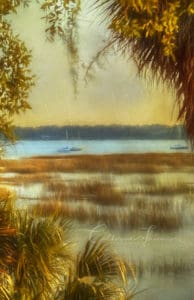Several years ago I was searching for a new story to write. My previous series featured an Oakland homicide detective, something I knew well because I was one. It took place in the San Francisco Bay area, where I had lived for twenty-five years. The plots came easily, as I could draw from hundreds of murder cases I had actually investigated.
I was living a post-law enforcement retired life with my wife in Sun City Hilton Head, near some of the most beautiful beaches in the country and an easy drive to Savannah and Charleston. We’re surrounded by world-class golf resorts, rivers that ebb and flow with the rise and fall of the tides, lush vegetation that remind us of Hawaii, live oaks dripping with Spanish moss, and a culture created from the melding of Southern hospitality, tourism, and an influx of retirees from those parts of the country where people still need to own snow shovels.

Credit: Catherine Thiem
We are still fascinated by the South Carolina Lowcountry. When golfing, we’re still mesmerized—and a bit wary—of alligators sunning next to the lagoons on the golf course. My wife, an avid photographer, is enthralled by the sight of the many wading birds on the beaches and mudflats of the tidal rivers: four diverse kinds of herons, three distinct types of egrets, ibis, spoonbills, storks, and others. Overhead bald eagles, ospreys, and vultures soar. Deer, racoons, foxes, rabbits, turkeys, and opossums are commonly seen in our neighborhood.
A ten-minute walk from our house takes us to a pier and fishing dock that juts out into a tidal river, which winds its way into the Atlantic Ocean. During high tide, the river resembles a lake, with Spartina grasses poking through the shallows of the salt marsh, and during low tide, thousands of oyster shells sit atop the exposed mudflats and pluff mud. We occasionally see a pod of dolphins swimming upriver. Two different worlds live in harmony down here. The high-end resorts and gated communities are filled with visitors and transplants from up north and restaurants serve steaks, pasta dishes and grilled local fish. New York, Boston, and Midwest accents abound. Drive inland a short way and most male diners wear baseball caps and tee shirts advertising their favorite beer. There, grits always accompany breakfast orders and dinner menus include fried fish, shrimp, and hushpuppies.
Living here provided a setting that would carry a novel, or even a series.

Credit: Catherine Thiem
Shortly after I moved here, I was asked to join the Beaufort Sheriff Office’s Cold Case Team, a group of retired detectives, prosecutors, and forensic pathologists. We meet monthly at the sheriff’s station on Hilton Head Island and review previously unsolved murder cases. Although the sheriff’s criminal investigators are extremely professional and highly trained, the investigators on the cold case team bring years of experience to the renewed investigations. At my very first meeting I realized I had personally investigated more murders in my first month working homicide than every investigator in the sheriff’s office had investigated that entire year.
As a writer, I knew that good stories often spring from several what ifs. The inspiration for the what ifs were right in front of me.
What if Sean, a retired homicide detective, moves to an active adult community on the beautiful coast of the South Carolina Lowcountry? What if he was asked to join the local sheriff’s cold case team? What if a murder occurred across the street from his house, and the local sheriff asked him to assist his less experienced detectives? What if the assigned sheriff’s detective, Charlotte, nicknamed Charlie, takes offense at her superiors for allowing a retired “Northerner” detective to stick his nose into her case?

Credit: Catherine Thiem
I had a great premise, but my protagonist needed to have some personal issues. After h is wife had supported him during his thirty-year career with its grueling hours and their children were grown, Sean promised to support her dream of a life of leisure in a tropical paradise. Then she dies, and Sean is left with no purpose. Because fishing and a lousy golf game could never be sufficient purpose for a man after a career where he made a difference. And then he’s asked to help investigate a fresh murder and work with the cold case team on a decades-old, unsolved one.
Because I didn’t want to be constrained by a real-world setting, I created a fictional place called Spartina Island. It was inspired by Hilton Head Island, as well as Edisto and Kiawah Island to the north, and the Georgia Sea Islands to the south. Just across the Spartina Island Bridge on the mainland, my fictional places are inspired by Bluffton, Beaufort, and surrounding areas. In addition to Sean and Charlie, I filled Spartina Island with diverse, interesting, and sometimes quirky characters.
Thus, my latest novel, The Mudflats Murder Club, was born.

BRIAN THIEM is the author of Red Line, Thrill Kill, and Shallow Grave. In his previous life, he spent 25 years with the Oakland Police Department, much of it working Homicide, and retired as a lieutenant. He’s also an Iraq War veteran, retiring from the Army as a lieutenant colonel after 28 years of active and reserve service. He holds an MFA in creative writing and is an adjunct professor at Western Connecticut State University. He’s a member of Mystery Writers of America, Sisters in Crime, International Thriller Writers, and the Island Writers Group. He lives and writes in Hilton Head, South Carolina, where he’s also a citizen volunteer on the sheriff’s Cold Case Team.





